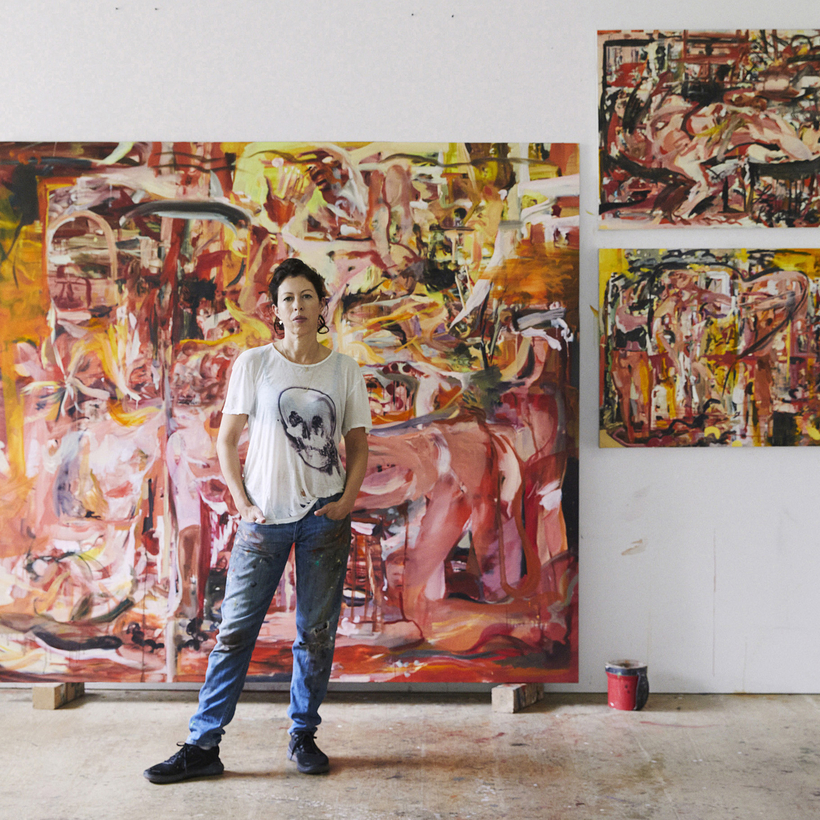“The other thing I would’ve liked to be, if I hadn’t been an artist, is an actor,” says Cecily Brown, as she flips through the exhibition catalogue of “Cecily Brown: Death and the Maid,” the first comprehensive survey of her work in New York, opening at the Metropolitan Museum of Art on April 4.
Brown’s finger pauses on her 1997 painting The Only Game in Town and re-traces the contour of its central figure: a beautiful young woman, peering into a mirror, confronted with the reflection of her aged, haggard self. It’s a classic memento mori image—the reminder that life is fleeting, and that death is waiting—but it’s also the title of a 1970 movie starring Elizabeth Taylor, one of many links between Brown and classic Hollywood movies that add layers of meaning, and misdirection, to her work.

Brown has always been elusive, both as a person and as a painter. Born just outside London, she graduated from the Slade School of Fine Art in 1993, at a time when figurative painting was heavily influenced by overbearing male artists such as Francis Bacon and Lucian Freud (both of whose work Brown’s biological father, the art critic David Sylvester, had boosted for decades).
For a young artist ready to push the boundaries of figurative painting, the atmosphere felt small and constricting, so Brown quickly made her way to New York. “Was I attracted to New York because I walk fast, or do I walk fast because I live in New York?,” Brown asks herself. When pressed, she answers, “I think I always walked fast.”

Brown’s paintings of the mid- to late 90s have a brisk bravura that catapulted her to fame. “They were very bright and very chaotic,” she says. “Very much like a Busby Berkeley song-and-dance routine, maybe with a hand grenade thrown into it.” The paintings often borrowed titles from classic Hollywood musicals—Seven Brides for Seven Brothers, High Society, Can-Can—that suggested a sense for the celluloid myths of our time but with a distinctly abstracted twist.
“Was I attracted to New York because I walk fast, or do I walk fast because I live in New York?”
The painting Father of the Bride, from 1999, centers on a pallid, almost feminine form, subsumed in a pandemonium of pink, black, and white Expressionistic pyrotechnics. But just as the viewer might be imagining a scene from the Elizabeth Taylor and Spencer Tracy movie of the same name, Brown insists that she assigns a title only after a painting is finished.

For her, titles are like readymades à la Marcel Duchamp—items already complete in themselves, which may or may not shed light on their surroundings, depending on where they’re placed. As it happens, Brown’s intention for the title Father of the Bride refers to Willem de Kooning and Jackson Pollock as the “fathers” of Abstract Expressionism, and to herself as the bride. “The young woman taking on the male mantle,” she explains. “It was very tongue in cheek.”
The Only Game in Town takes its name from the 1970 Warren Beatty and Elizabeth Taylor drama about an aging Las Vegas chorus girl and a gambling-addicted cocktail-lounge pianist, and hints at dissipation and dissoluteness. But Brown’s canvas has a macabre theatricality all its own.
Based on Charles Allan Gilbert’s 1892 drawing All Is Vanity, in which a lady’s dressing-table mirror forms the shape of a skull, and also on William Ely Hill’s 1915 optical-illusion etching, My Wife and My Mother-in-Law, in which the viewer can discern either a young woman or an old lady, Brown’s painting shows the grim reality of its subject from every angle. Like the bloodshot eyeball at the edge of the canvas, plucked from the paintings of Philip Guston, the audience can’t turn away from the horrible, irresistible spectacle on offer.

But the cinematic qualities in Brown’s work go well beyond her titles. The Only Game in Town depicts rows of spectators (the eyeball, the subject, the reflection) watching one another, and even a mirror—a screen of sorts—at its center, reflecting the scene back on itself. Time lapses through these many layers of space, and the composition, as Brown puts it, “unspools before your eyes, almost like a movie compressed into one piece.”
This becomes increasingly apparent in Brown’s recent work, where forms are ever more conflated and merge seamlessly into one another. Selfie, 2020, painted during the pandemic, presents an almost claustrophobic interior, cluttered with objects. With each glance, the viewer discerns fresh elements (a window, an easel, a dressing table) which disappear as quickly as they emerge from the canvas.

This proves as frustrating—and, sometimes, as rewarding—to the artist as to the viewer. “Just show it once, for God’s sake!,” Brown admonishes herself. “Or just decide—is it a dressing table or is it a window or is it a reflection?”
This isn’t really a question. Brown’s art is as mysterious as ever, whether it’s unfolding on a movie-theater big screen or as a cell-phone selfie. Coyly, it offers answers one second and changes them the next. It expects a viewer to be patient, to look, to see, to discover the delicious ambiguity it has to offer. But that’s what great art is all about. “I’ve always said painting was the only game in town for me,” says Brown.
Patrick Monahan is a New York–based freelance writer and art adviser. He contributes regularly to publications in the U.S. and the U.K.
